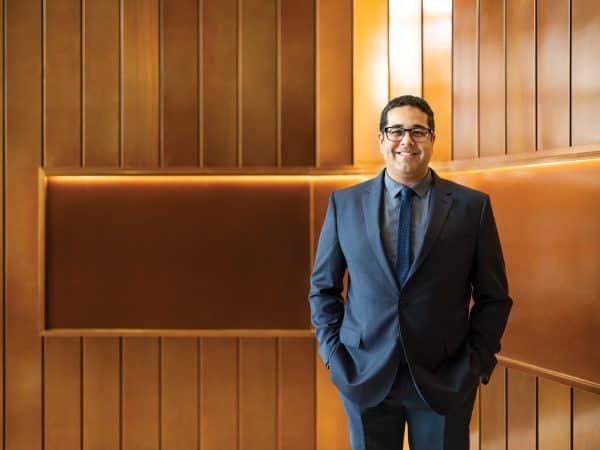From a lab bench to a brachytherapy suite to a board room, cancer care in Alberta is a team effort with a diverse cadre of expert players.
By Doug Horner
Photographs by Ryan Parker, Jonathan Ferguson and Dhakshayini Boopalan
Cancer treatment in Alberta has made a quantum leap over the past 40 years. Advancements in screening, diagnosis and treatment have translated to earlier detection, improved survival rates and a more comfortable experience for patients. The road to recovery for many Albertans has become shorter and smoother.
The province’s capacity to meet such a complex and ongoing challenge depends on attracting and retaining a vibrant ecosystem of clinicians, researchers, scientists and administrative leaders. Four health care professionals reflect on how far cancer care has come, how their careers have unfolded and how working in Alberta has contributed to their success.
Dr. Anthony Fields
Retired oncologist
Professor emeritus, department of oncology, University of Alberta
Inaugural chancellor, MacEwan University (from 2021 to 2025)

When he looks back on his 45-year-long career as a medical oncologist, professor and administrative leader, Dr. Anthony Fields describes his work as either a “pleasure” or a “privilege.” And perhaps that’s been his secret to making such a profound difference for so many Albertans and Canadians. His job never felt like work. It was a calling.
In 2024, Fields was awarded the Frederic Newton Gisborne Starr Award, the highest distinction given by the Canadian Medical Association, in recognition of his visionary leadership in cancer care. He was previously named one of Alberta’s top 100 physicians of the century and is a member of the Order of Canada. Originally from Barbados, Fields married an Edmontonian and moved to the city in the 1960s. He graduated from medical school in 1974 and began working as an oncologist, specializing in gastrointestinal cancers, at the Cross Cancer Institute (Cross) in 1980. Eight years later, he was leading the Cross through an expansion that doubled its size and capacity.
Fields never anticipated taking on such big-picture, administrative roles, but his aptitude for leadership and strategic thinking was recognized early on in his career by the public sector and charitable organizations alike. Alberta’s reputation for putting ambitious ideas for cancer research and treatment into practice also provided the ideal environment for him to put those skills into action. Fields helped create Alberta’s 11 community cancer centres so patients could receive treatment much closer to home. He was involved in forming the department of oncology at the University of Alberta and helped develop Canada’s first nationwide plan for cancer. He also spearheaded the creation of a national organization to evaluate and approve new cancer medications.
With the benefit of hindsight, Fields can draw a connection between the face-to-face relationships he had with patients and his administrative work building new organizations to address the challenges of cancer on a much larger scale. The leadership positions were a way to help the people he didn’t get to see in his practice. “I intensely loved my interaction with patients, but I also loved participating in building things that would have a positive effect on people I would never see,” he says.
What inspires you?
“To encourage people to buy into a vision and then to draw on their expertise and help them work as teams to realize that vision. Of the several things that I have been given credit for achieving, I can’t think of one that I could have done by myself.”
Dr. Tyler Meyer
Medical physicist, Arthur J.E. Child Comprehensive Cancer Centre
Adjunct associate professor, departments of oncology and physics and astronomy, University of Calgary

Dr. Geetha Menon and Dr. Tyler Meyer are seeing exciting developments as medical physicists with a specialty in brachytherapy — a type of internal radiation therapy. Meyer works at the Arthur J.E. Child Comprehensive Cancer Centre (Arthur Child) in Calgary, and Menon is in Edmonton at the Cross Cancer Institute. Many of the goals that each of them charted several years ago are now coming to fruition for patients.
Meyer credits the Alberta Cancer Foundation and its donors with providing the essential financial support for homegrown experts like him and Menon to find traction in the highly competitive field of brachytherapy. “I grew up here. I took all of my training here and I practiced here, and I can see the difference that those investments have made over a 20-year period,” he says.
Every so often, Meyer and his team are reminded just how far they’ve come in terms of the quality of care they provide to Albertans with cancer. One such moment occurred recently after a patient completed her third and final brachytherapy treatment. “She was so happy because she was expecting what had happened the first two times, and she didn’t have to go through that again,” Meyer explains.
Brachytherapy involves surgically implanting small sources of radiation inside cancerous tissue. It’s an effective option for otherwise difficult-to-treat cancers, such as gynecological and prostate cancers. The procedure itself, however, can be long and arduous. “It’s really hard on patients,” says Meyer. “And when you’re coming back for your third treatment, it’s intimidating [because] you know what it is.”
The patient had started her treatment at the former Tom Baker Cancer Centre, but finished it at the new Arthur Child. The brachytherapy suite at the Arthur Child integrates technologies, including an MRI available right in the operating room, which meant she could be anesthetized for her final treatment. Unlike at the Tom Baker, she didn’t need to be moved to access an MRI, so she didn’t need to be awake. “It’s a very unique design. There’s only a couple even similar to it in North America,” Meyer says of the new suite.
What inspires you?
“It’s really nice to come to work every day and work towards the same goal and have that matter to everyone. Everybody knows why we’re doing it and the impact that it can have, and they’re always willing to go the extra mile.”
Dr. Geetha Menon
Senior medical physicist, Cross Cancer Institute
Clinical professor, department of oncology, University of Alberta

Menon shares her colleague’s enthusiasm for the trajectory of brachytherapy in the province over the past few decades. “The way that we deliver these treatments now is really awesome,” she says. From the design of the applicators to imaging to the afterloaders (the machines that deliver the radiation), each step has seen meaningful improvements, allowing oncologists to provide more effective treatments that are better calibrated for the individual anatomy of each patient.
Local experts like Meyer and Menon have played a big part in the research that set the stage for these innovations. One of Menon’s current projects looks at how to implement AI and machine learning into the brachytherapy workflow. Studying MRI images and mapping the position of cancer relative to organs, other healthy tissues and the implanted radiation applicator takes several hours. Automating these data-analysis stages of the treatment would save significant time. “Even if you can shave off about three hours, it’s a huge deal in a seven- to eight-hour work day,” she says.
Menon’s research has the potential to make brachytherapy treatments shorter and much more comfortable for patients. The implementation of AI could also dramatically increase the capacity of the brachytherapy suites in both Calgary and Edmonton. “It’s a very gratifying job just to see that a patient gets treated at the appropriate time, recovers from cancer, and that’s all because you are one of those [links] in that big chain,” she says.
What do you love most about your work?
“I cannot do anything here by myself. It’s a team effort. Everybody in that team is important. You cannot treat people with cancer without this whole team.”
Dr. Micheal Weinfeld
Senior research scientist, Cross Cancer Institute
Professor, department of oncology, University of Alberta

Now in the final fruitful years of a distinguished career as a research scientist and professor, Dr. Michael Weinfeld is still driven by curiosity. That’s what first brought him to Edmonton 40 years ago, when he decided to go with his then-lab, led by Dr. Malcolm Paterson, when it moved across the country from the Chalk River Nuclear Laboratories in Ontario to the Cross Cancer Institute.
Weinfeld describes how the Alberta Heritage Foundation for Medical Research had been a fantastic magnet for drawing exceptional scientists from across Canada and the United States to set up shop in Calgary and Edmonton. That former funding program, Weinfeld emphasizes, serves as a powerful example of how public investment supports the nuts-and-bolts science that then drives innovation in patient care.
And that’s exactly what Weinfeld aims for in his current research. “What I’d really like to see is that the basic research my lab’s been involved with over the years does eventually help patient care. That’s why I got into cancer research in the first place.”
Every form of life, from bacteria to humans to tumours, has built-in mechanisms for repairing DNA after it gets damaged. Alberta is recognized as a leader in the field of DNA repair, which Weinfeld has built his career in. He has relied on collaboration to make this possible, drawing on multidisciplinary expertise from across the province, including chemists, pharmacists, biochemists and computer scientists, to figure out ways to target and disrupt DNA repair in cancer cells but not in healthy tissues.
This tactic makes treatments like radiation and chemotherapy more toxic to cancer, so you can achieve the same results with lower doses of radiation. PNKP, for example, is one of the proteins involved in several DNA repair pathways. Weinfeld and his team found they could express the gene in bacteria so they could produce a lot more of the protein, enabling labs worldwide to study the protein more efficiently. “That was a good day when we made those discoveries,” he says.
Another one of his projects focused on treating colorectal cancer in mice using PNKP inhibitors. By developing a method of attaching the inhibitors to nanoparticles, Weinfeld and his team could better target the treatment to cancer cells.
“At the heart of my work, it’s been wonderful in the sense that it’s been curiosity-driven, which is kind of a luxury,” Weinfeld says.
What do you love most about your work?
“It’s the excitement of doing something nobody else has ever done before — of making a discovery, usually a small discovery, but it’s something that makes your day and seeing a smile on the face of your student or your technologist who did that work.”

